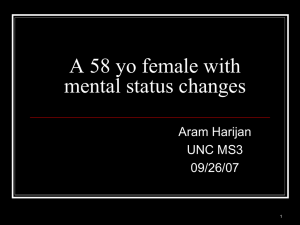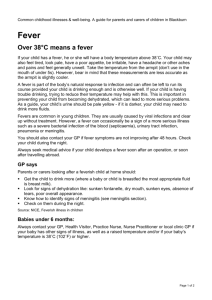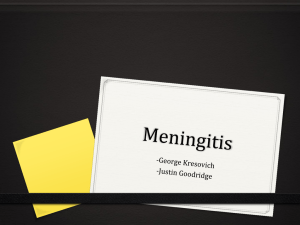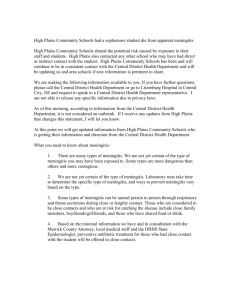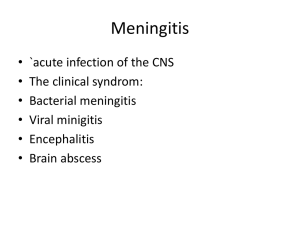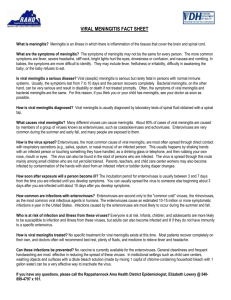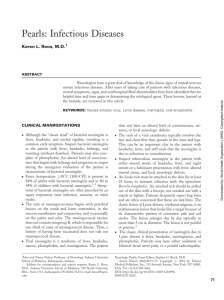Viral Respiratory Tract Infections
advertisement
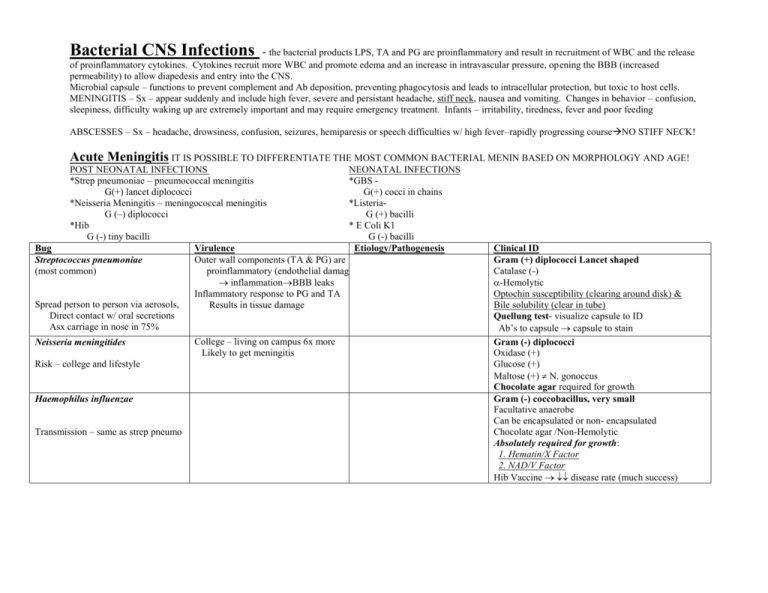
Bacterial CNS Infections - the bacterial products LPS, TA and PG are proinflammatory and result in recruitment of WBC and the release of proinflammatory cytokines. Cytokines recruit more WBC and promote edema and an increase in intravascular pressure, opening the BBB (increased permeability) to allow diapedesis and entry into the CNS. Microbial capsule – functions to prevent complement and Ab deposition, preventing phagocytosis and leads to intracellular protection, but toxic to host cells. MENINGITIS – Sx – appear suddenly and include high fever, severe and persistant headache, stiff neck, nausea and vomiting. Changes in behavior – confusion, sleepiness, difficulty waking up are extremely important and may require emergency treatment. Infants – irritability, tiredness, fever and poor feeding ABSCESSES – Sx – headache, drowsiness, confusion, seizures, hemiparesis or speech difficulties w/ high fever–rapidly progressing courseNO STIFF NECK! Acute Meningitis IT IS POSSIBLE TO DIFFERENTIATE THE MOST COMMON BACTERIAL MENIN BASED ON MORPHOLOGY AND AGE! POST NEONATAL INFECTIONS NEONATAL INFECTIONS *Strep pneumoniae – pneumococcal meningitis *GBS G(+) lancet diplococci G(+) cocci in chains *Neisseria Meningitis – meningococcal meningitis *ListeriaG (–) diplococci G (+) bacilli *Hib * E Coli K1 G (-) tiny bacilli G (-) bacilli Bug Virulence Etiology/Pathogenesis Outer wall components (TA & PG) are Streptococcus pneumoniae (most common) proinflammatory (endothelial damage inflammationBBB leaks Inflammatory response to PG and TA Spread person to person via aerosols, Results in tissue damage Direct contact w/ oral secretions Asx carriage in nose in 75% Neisseria meningitides Risk – college and lifestyle Haemophilus influenzae Transmission – same as strep pneumo College – living on campus 6x more Likely to get meningitis Clinical ID Gram (+) diplococci Lancet shaped Catalase (-) -Hemolytic Optochin susceptibility (clearing around disk) & Bile solubility (clear in tube) Quellung test- visualize capsule to ID Ab’s to capsule capsule to stain Gram (-) diplococci Oxidase (+) Glucose (+) Maltose (+) N. gonoccus Chocolate agar required for growth Gram (-) coccobacillus, very small Facultative anaerobe Can be encapsulated or non- encapsulated Chocolate agar /Non-Hemolytic Absolutely required for growth: 1. Hematin/X Factor 2. NAD/V Factor Hib Vaccine disease rate (much success) Neonatal Bacterial Meningitis Streptococcus agalactiae/ Group B Listeria monocytogenes Risk – immunocomp, young, old, pregnancy Infected moms – mild flu like Sx, but have miscarriage, stillbirth, premature delivery or infection of newborn Presumptive ID - CAMP Test (+) - staph sphingomyelinase - GBS camp factor - enhanced zone of hemolysis Definitive ID – lancefield sero. B Infection in newborn: - Rhombencephalitis lesions - Liver with microabscesses - Pyomatous microabscess Dx as Granulomatous infantiseptica E Coli K1 Gram (+) cocci in chains Catalase (-) Hemolytic Treat w/ IV AB’s during delivery Gram (+) bacillus Catalase (+) Tumbling motility @ 25 - culture Semisolid media – umbrella shaped growth ß hemolytic G (-) rod Lactose fermenter – (mac = pink) Ox (-) Chronic Meningitis- CMI Immunocompromised most susceptible Bug Cryptococcus neoformans (Yeast) (most common menin in HIV) Virulence Etiology/Pathogenesis Risk - IMMUNOCOMPROMISED Clinical ID Gram (+) (yeast) India Ink- negative stain to see capsule Calcofluor- florescent stain for fung Urease (+) (also a virulence factor) Detect capsular antigen in CSF or serum Titer to monitor therapy Abscess- Most polymicrobial – Sx – headache, drowsiness, confusion, hemiparesis, seizures, speech difficulties w/ fever BUT NO stiff neck! Bug Borrelia burdorderi (lyme disease) Virulence Etiology/Pathogenesis Clinical ID 1º infection- dissemination, inflammation, *meningitis is aseptic b/c only have characteristic skin lesion inflammation left, bacteria are gone Most common in NE and now midwest after mo. localization to tissue (CNS etc Guillan barre - demyelinating disorde Guillian barre due to cross reactivity Campylobacter Jejuni (post infectious syndrome) Resulting in acute neuromuscular paralysis b/w microbial gangliosides & neural characterized by and immunologic attack upon antigens peripheral nerve myelin Sx – acute, widespread disease of brain Risk – travel to endemic areas and Plasmodium Species Accompanied by recurrent episodes of Under 10 years of age Fever, chills, anemia – “malarial fever”

